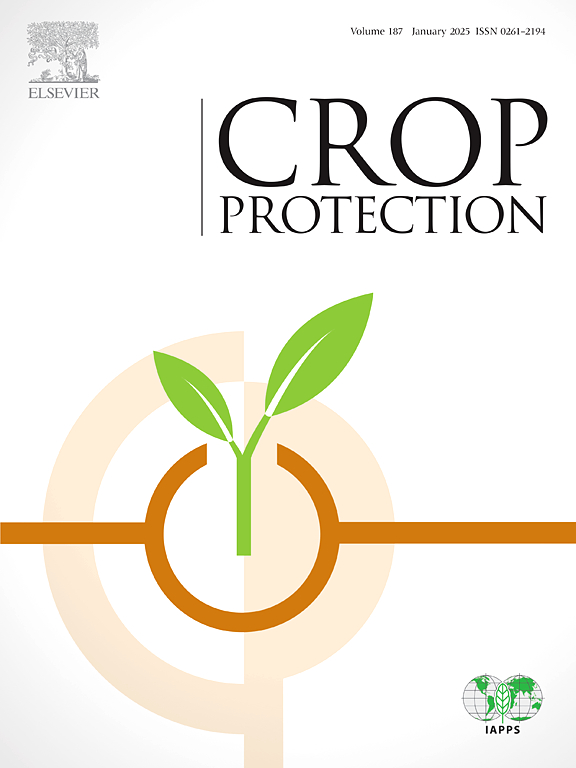人工合成杀菌剂和植物基杀菌剂对龙果溃疡病的体外敏感性和田间药效比较
IF 2.5
2区 农林科学
Q1 AGRONOMY
引用次数: 0
摘要
火龙果溃疡病(DFC)是由新锡塔菌(Neoscytalidium dimidiatum)引起的,威胁着全球火龙果产业的盈利能力。在美国,为这种作物登记的杀菌剂数量有限,对DFC的有效控制提出了挑战,特别是在经常发生疫情的南佛罗里达州。本研究评估了N. dimidiatum分离物对13种合成杀菌剂和4种植物基杀菌剂的体外敏感性,并评估了最有希望的候选杀菌剂对离体果实和田间试验的效果。合成杀菌剂氟西那姆、氟嘧唑尼、二苯唑康唑、丙环康唑、戊唑康唑和嘧菌酯的有效浓度最低(EC50),范围为0.01 ~ 1.48 μg/ml,表明在较低浓度下对体外菌丝生长有较强的抑制作用。相比之下,植物基杀菌剂百里香油和大蒜油的EC50值更高(分别为35.38 μg/ml和37.10 μg/ml),在离体水果试验中对DFC症状的预防效果较差。替布康唑是离体水果试验中最有效的药剂之一,对DFC的防治效果在95%以上,但在田间的防治效果降至50%。田间试验表明,氟嗪南是试验中最有效的杀菌剂,可将水果中的DFC严重程度降低93%。杀真菌剂在茎上的药效低于果实,田间药效均不超过65%。这是第一个在美国调查双翅状芽孢杆菌对多种杀菌剂敏感性的研究。鉴于其在田间试验中的优异表现,氟嗪南是一种很有前途的DFC控制候选者,应该进一步考虑在美国注册。本文章由计算机程序翻译,如有差异,请以英文原文为准。
In vitro sensitivity and field effectiveness of synthetic and plant-based fungicides against dragon fruit canker caused by Neoscytalidium dimidiatum
Dragon Fruit Canker (DFC), caused by Neoscytalidium dimidiatum , threatens the profitability of the dragon fruit industry worldwide. In the U.S., the number of fungicides registered for this crop is limited, challenging the effective control of DFC, particularly in South Florida, where frequent outbreaks occur. This study evaluated the in vitro sensitivity of N. dimidiatum isolates to 13 synthetic and four plant-based fungicides and assessed the efficacy of the most promising candidates on detached fruit and in field trials. The synthetic fungicides fluazinam, fludioxonil, difenoconazole, propiconazole, tebuconazole, and azoxystrobin had the lowest effective concentration values (EC50 ), ranging from 0.01 μg/ml to 1.48 μg/ml, indicating strong inhibition of mycelial growth in vitro at minimal concentrations. In contrast, the plant-based fungicides thyme oil and garlic oil demonstrated higher EC50 values (35.38 μg/ml and 37.10 μg/ml, respectively) and proved ineffective in preventing DFC symptoms in detached fruit assays. Tebuconazole was one of the most effective chemicals in detached fruit assays, with over 95% efficacy in controlling DFC, but its effectiveness decreased to 50% in the field. Field trials revealed that fluazinam was the most effective fungicide tested, reducing DFC severity in fruits by 93%. Fungicide effectiveness was lower on stems than fruits, with none exceeding 65% efficacy in the field. This is the first study to investigate the sensitivity of N. dimidiatum isolates to multiple fungicides in the U.S. Given its superior performance in field trials, fluazinam is a promising candidate for DFC control and should be considered further for registration in the country.
求助全文
通过发布文献求助,成功后即可免费获取论文全文。
去求助
来源期刊

Crop Protection
农林科学-农艺学
CiteScore
6.10
自引率
3.60%
发文量
200
审稿时长
29 days
期刊介绍:
The Editors of Crop Protection especially welcome papers describing an interdisciplinary approach showing how different control strategies can be integrated into practical pest management programs, covering high and low input agricultural systems worldwide. Crop Protection particularly emphasizes the practical aspects of control in the field and for protected crops, and includes work which may lead in the near future to more effective control. The journal does not duplicate the many existing excellent biological science journals, which deal mainly with the more fundamental aspects of plant pathology, applied zoology and weed science. Crop Protection covers all practical aspects of pest, disease and weed control, including the following topics:
-Abiotic damage-
Agronomic control methods-
Assessment of pest and disease damage-
Molecular methods for the detection and assessment of pests and diseases-
Biological control-
Biorational pesticides-
Control of animal pests of world crops-
Control of diseases of crop plants caused by microorganisms-
Control of weeds and integrated management-
Economic considerations-
Effects of plant growth regulators-
Environmental benefits of reduced pesticide use-
Environmental effects of pesticides-
Epidemiology of pests and diseases in relation to control-
GM Crops, and genetic engineering applications-
Importance and control of postharvest crop losses-
Integrated control-
Interrelationships and compatibility among different control strategies-
Invasive species as they relate to implications for crop protection-
Pesticide application methods-
Pest management-
Phytobiomes for pest and disease control-
Resistance management-
Sampling and monitoring schemes for diseases, nematodes, pests and weeds.
 求助内容:
求助内容: 应助结果提醒方式:
应助结果提醒方式:


